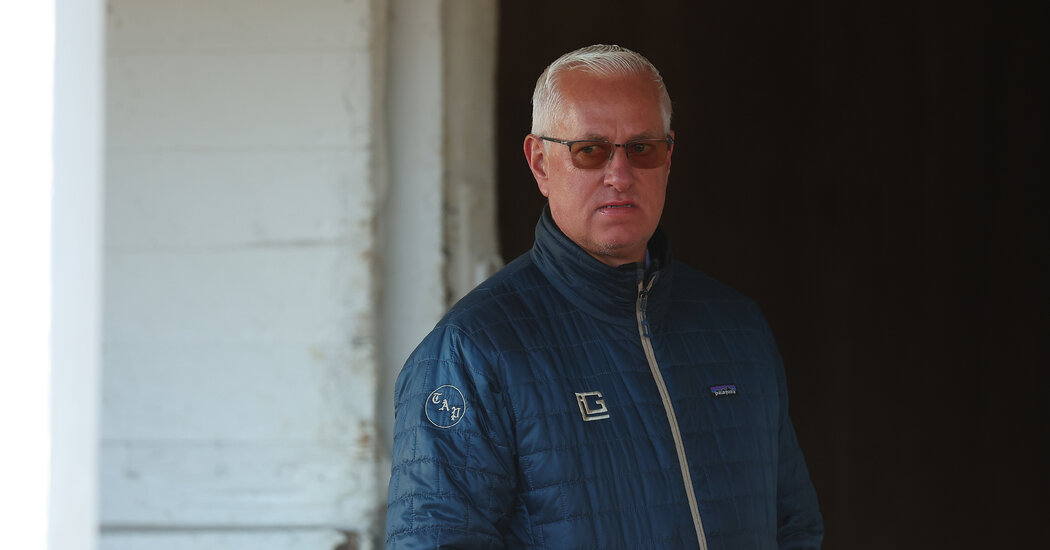What Courtney Dauwalter Learned in the Pain Cave
After running for 60 miles through snow, up steep, root-filled switchbacks with thousands of feet of elevation gain, Courtney Dauwalter entered what she calls her pain cave. For the next 40 miles of the Western States 100-Mile Endurance Run through California’s Sierra Nevada, she imagined she was holding a chisel and chipping away at the furthest reaches of her pain, while staying focused on every step she took. By the time Dauwalter crossed the finish line in 15 hours, 29 minutes and 33 seconds, she had obliterated the women’s course record by more than an hour and had run the 23rd-fastest time, by anyone, in the race’s 45-year history.
To put Dauwalter’s time in perspective, it would have won the men’s division of Western States — arguably the most competitive 100-mile race in the world — every year from 1978 through 2009. Scott Jurek won Western States seven times (most recently in 2005) but never once ran as fast as Dauwalter did this year. She beat a 1994 Western State record set by Ann Trason, who won the race 14 times, by more than two hours.
Dauwalter is one of the most colorful characters in ultrarunning. She is known for her love of candy, nachos and beer, as well as her loose shorts and her vivid on-course hallucinations, which are illustrated on hats and T-shirts. In the past 10 years, she has won more than 50 races of 30 miles or longer. In 2017, she won a 240-mile race in Moab, Utah, by 10 hours. In winning Big Dog’s Backyard Ultra in 2020, she ran 283 miles and hallucinated that Mickey Mouse was standing on a circus stage handing out T-shirts to a crowd.
Now she is trying to do something even the most accomplished ultrarunners would consider extraordinary: win three highly competitive 100-mile races in a single summer. Twenty days after her performance at Western States, she won the grueling Hardrock 100 in Silverton, Colo., breaking her own record by 20 minutes and placing fourth overall. This weekend, seven weeks after winning Hardrock, she will toe the line at the Ultra Trail du Mont-Blanc, a brutally steep, 106-mile race in Chamonix, France, with terrain more suited to billy goats than humans. She has won the race twice and currently holds the women’s record.
“In general, I am pretty tired,” said Dauwalter, whose mottos when things get tough in a race are “This is fine” and “Be brave and believe.” She said running all three races was not the plan at first, but that she just had to try it.
“I am so curious what will happen and excited to test myself,” she said.
Lanky and blond, with a deep tan, expressive blue eyes and permanent laugh lines, Dauwalter, 38, believes one of the greatest evolutions in her running career has been her embrace of the “pain cave.” Initially, she thought of it as the place where she could no longer bear the suffering and would have to stop running. Indeed, she quit the first 100-mile race she attempted in 2012 because she was overwhelmed by pain. But as she ran more races, she started to understand that she could work through it. She said she envisioned herself in a hard hat, wielding a chisel and “going to town, trying to make it a dust pile while I am in there.”
She continued: “It feels like this is a special opportunity every time it arrives because we can’t summon it whenever we want. We have to be doing something hard, push ourselves, and then maybe we will get the chance to go in. And if we do, we should celebrate that we get to be there.”
Sitting on a deck that overlooks the Rockies at her home in Leadville, Colo., on a sunny, mid-August afternoon, Dauwalter sipped a fruity seltzer and pointed to two 14,000-foot mountains that she often runs to from her house. In a sport where most elite runners have a coach and map out their training schedules weeks in advance, Dauwalter trains herself and does not know how many miles she will run on any given day. Her mornings usually begin around 4 a.m. with a cup of coffee with vanilla crunch creamer. She responds to emails, then does about 40 minutes of strength training. By 7 a.m., she hits the trail and runs for an hour to five hours. She often adds a bike ride and a second run with her husband, Kevin Schmidt.
“I try and go into every week really open to whatever happens so that I will actually tune into my body and listen to it,” said Dauwalter, who wears a running watch but does not post her workouts on popular running apps like Strava, as many ultrarunners do. “If I go into a week thinking it is going to be a really big mileage week or I have all these grand ideas about it, then I find it harder to listen to my body and actually respond to what it is telling me.” Her big mileage weeks are often 140 miles.
Schmidt, a software engineer who said he didn’t know about ultramarathons until he met Dauwalter over a decade ago, tracks the possible mile splits she could have and meticulously plans the support stations along the course. Though Schmidt sets time goals, the couple does not focus on them or get too confident about a race until Dauwalter is at the finish line. In 2019, she was leading Western States, but had to drop out at mile 80 because of a leg injury. In 2021, her stomach issues were so severe at Hardrock that she couldn’t go on. Even when all goes as planned, random events can intervene, like when Dauwalter had to go off course to avoid a moose or lost her vision when her corneas swelled from the dust on the trail.
The pair said that nutrition is now a big part of their plan. A friend who works as a dietitian said Dauwalter had stomach problems in races because she was not getting enough calories. Dauwalter now picks up a plastic bag at each support station filled with an assortment of gels and energy waffles and carries water and a sports drink. Her job is to hand back a bag with empty wrappers.
Schmidt believes Dauwalter’s supportive family and her athletic background in her home state of Minnesota helped her learn to be aware of what she was feeling. She ran cross-country in high school and was a state champion Nordic skier, which earned her a skiing scholarship to the University of Denver.
“She had fantastic parents who raised her really well, encouraged her to be competitive and didn’t put restrictions on her, so she never felt like she couldn’t compete against her brothers,” Schmidt said. “And she had really great coaches who taught her how to be in tune with her body, which I think has helped her have this very unstructured training format that works for her.”
Meghan Hicks, the editor in chief of iRunFar, an ultrarunning website, said many runners unintentionally set limitations on themselves by focusing on a course record and the splits it will take to beat it.
“Courtney does not work that way,” she said. “She goes and runs by the way she is feeling.”
Hicks said Dauwalter has “a wide-open approach that you don’t see a lot of runners doing and I think that is perhaps part of her key to success.”
Dauwalter’s performances have led some to wonder whether women will become faster than men as distances get longer. Dr. Sandra Hunter, the director for the Athletic and Human Performance Research Center at Marquette University, said they will not. Men’s physiological and anatomical advantages, including less body fat, greater hemoglobin and higher oxygen uptake, mean that they will always be faster overall, she said.
For example, Jim Walmsley, who holds the men’s record for Western States with a time that is about 9 percent faster than Dauwalter’s. According to an article in Sports Medicine, in major ultra trail races where the best men and women are present, this number rarely dips below 8 percent. That was the difference between Dauwalter’s time and the fastest men’s time at Ultra Trail du Mont-Blanc in 2021. The gap between the best male and female performances for running events from sprints to marathons usually hovers around 10 to 12 percent.
“There is a fundamental sex difference between males and females that won’t go away,” Hunter said. But Hicks said women have reached a place in ultrarunning where they need not be compared to men because their performances are valid without that comparison — a view widely held by women in the sport.
Hunter said Dauwalter’s running economy, which is measured by the oxygen consumption of a runner at a set speed and often improves as runners get older, may be superior to most other participants in the sport. While there has been a boom of women ultramarathoners, there are still far fewer women than men in ultra running, and they usually run shorter distances like the 50K. Hunter said that Dauwalter’s stellar performance shows that there is still a great deal of room for women to evolve.
Dauwalter, who is known for being generous with her time and cheering on the people around her, continues to elevate others in the sport, especially women, Hicks said. In 2020, when Hicks set the fastest known supported women’s time in a roughly 90-mile challenge called Nolan’s 14, which involves hiking and running 14 14,000-foot mountains, Dauwalter paced her through the night, telling jokes and stories to make the time pass. Around midnight, she asked Hicks if she wanted a bite of pizza and pulled out a slice wrapped in tinfoil from her pack.
“Who does that?” Hicks asked. “Maybe your husband or your best friend? But who in the top of the sport is doing that?”
Dauwalter’s approach to the business of running reflects her desire to lift others in the sport. She used her sponsorship with Salomon to influence a new line of women’s running shorts that are longer and looser than most shorts on the market. Dauwalter hopes that the shorts will give women another option to be comfortable and that maybe “the length is the thing that makes someone get out on the trail and try.”
She also wants to inject some humor into what can be an intense pursuit. Recently, Tailwind Nutrition debuted a “Make New Friends” line of T-shirts and hats featuring images that Dauwalter has seen in hallucinations on the trail: a giant cowboy, puppets on a swing set, a giraffe.
John Medinger, the former publisher of UltraRunning Magazine, has been at every Western States since 1983 and has collected statistics on the race for over four decades. Dauwalter’s performance can’t be quantified, he said. No runner has posted times like hers in such a wide range of races — fast ones, steep ones, extraordinarily long ones and races of attrition in which the last person standing wins.
“There are courses for horses and horses for courses, but I’m not sure there’s a course that isn’t a good one for Courtney,” he said.


